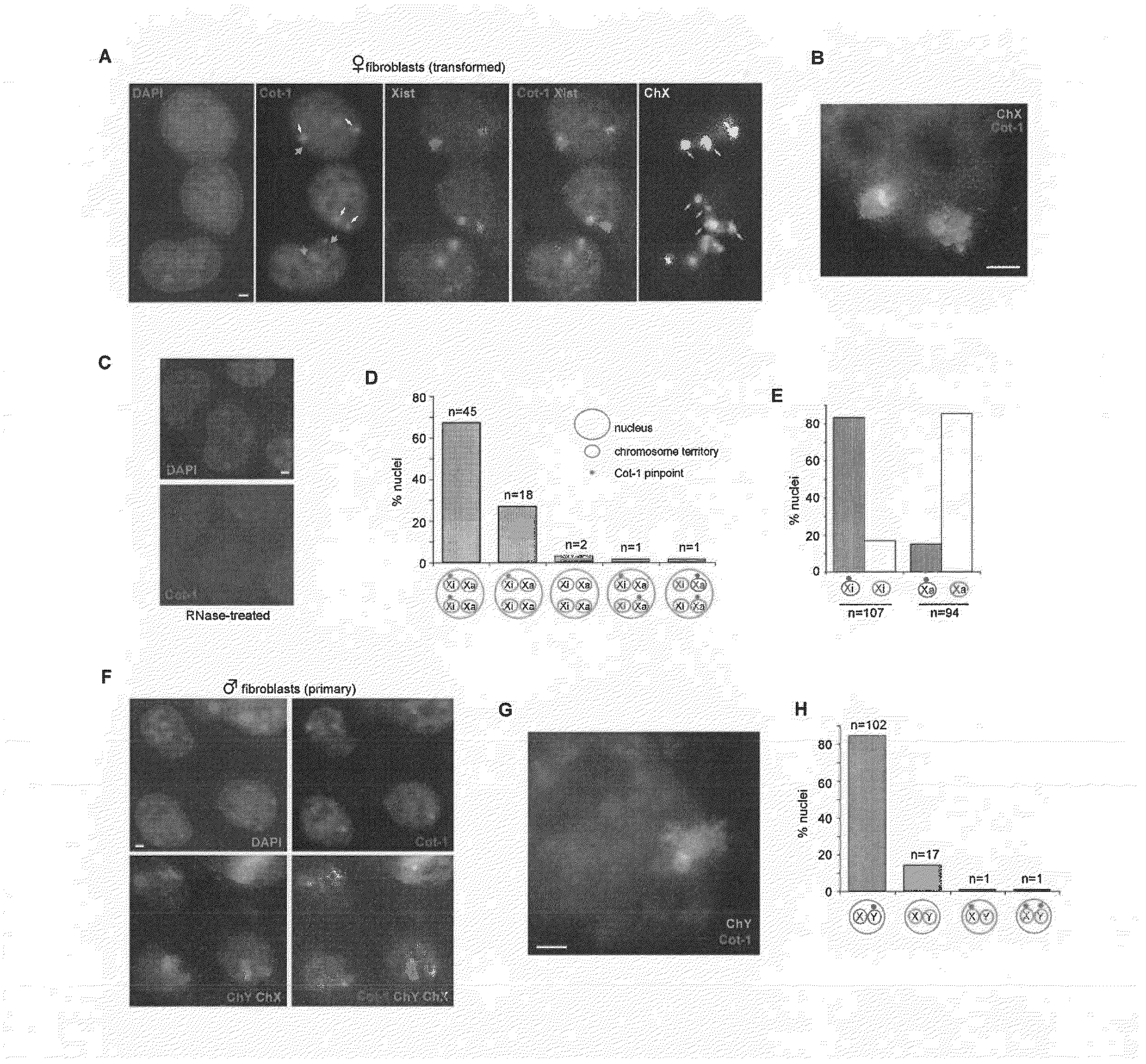Methods and compositions for identifying undifferentiated stem cells and assessing cell health
a technology of stem cells and compositions, applied in the field of methods and compositions for identifying undifferentiated stem cells and assessing cell health, can solve the problems of the need to maintain the stem cells in the undifferentiated state, the therapeutic potential of these cells is almost limitless, and the usefulness of these cells, so as to reduce or prevent the clinician or investigator's ability to modify
- Summary
- Abstract
- Description
- Claims
- Application Information
AI Technical Summary
Benefits of technology
Problems solved by technology
Method used
Image
Examples
example 1
Telomeric Pinpoint RNAs Mark the Sex Chromosomes of Stem Cells and Somatic Cells
[0179]Examples of epigenomic regulation by macroRNAs exist across all of biology. In fission yeast and plants, centric heterochromatin depends on co-transcriptional recruitment of the RNAi and silencing machineries by expressed ncRNA within retrotransposons. In the fruitfly, dosage compensation of the X-chromosome requires the action of roX1 and roX2, two macroRNAs associated with the MSL complex that directs hypertranscription of the male X-chromosome. In mammals, macroRNA function is exemplified by Xist (Borsani et al., Nature 351:325 (1991); Brockdorff et al., Nature 351:329 (1991); Brown et al., Nature 349:38 (1991)) and its antisense partner, Tsix (Lee and Lu, Cell 99:47-57 (1999))—two genes that control the initiation of ‘X-chromosome inactivation’ (XCI). XCI is induced by Xist RNA, a 17-kb ncRNA that accumulates in cis and recruits silencing factors to the X destined to be inactivated (Clemson et ...
example 2
RNA FISH
[0214]Below, we provide an exemplary protocol for RNA FISH that can be used in the methods of the invention for the detection of TeloRNA marks.
Preparation of Probe:
[0215]Probes are prepared using Boehringer Mannheim nick translation kit or Stratagene random prime labelling kit essentially as recommended by manufacturer. Generally, biotin-16-dUTP in combination with digoxigenin-11-dUTP is used. After labelling, the probe is precipitated with mouse Cot1 DNA (if your probe contains cross-hybridizing repetitive DNA) or yeast tRNA (if no repeats), 0.3M Na-acetate and 2 volumes EtOH at 4° C. for 1 hour. The probe is then spun and resuspended in hybridization buffer at 2 ng / μl probe DNA. Hybridization buffer: 50% formamide (American Bioanalytical), 2×SSC-pH7.4 (autoclaved), 2 mg / ml BSA (Boehringer Mannheim), 10% Dextran sulfate-500K (autoclaved). For hybridization, the probe is denatured at 75° C., 10 minutes. If probe contains repetitive elements, preanneal the probe at 42° C., 10...
example 3
RNA / DNA FISH
[0228]Below, we provide an exemplary protocol for RNA / DNA FISH that can be used in the methods of the invention for the detection of TeloRNA marks.
Preparation of Probe:
[0229]The probes prepared using Boehringer Mannheim nick translation kit or Hi-Prime kit essentially as recommended by manufacturer. One preferred probe is biotin-16-dUTP in combination with digoxigenin-11-dUTP. After labelling, the probe is precipitated with mouse Cot1 DNA (if your probe contains cross-hybridizing repetitive DNA) or yeast tRNA, 0.3M Na-acetate and 2 volumes EtOH at 4° C. for 1 h, spun, and resuspended in hybridization buffer at 2 ng / μl probe DNA. Hybridization buffer: 50% formamide, 2×SSC, 2 mg / ml BSA, 10% Dextran sulfate-500K. For hybridization, the probe is denatured at 85° C., 10 minutes. If the probe contains repetitive elements, the probe is preannealed at 42° C., 10-60 minutes (length of preannealling depends upon the repeats present).
Preparation of Slides:
[0230]Cells are grown dire...
PUM
 Login to View More
Login to View More Abstract
Description
Claims
Application Information
 Login to View More
Login to View More - R&D
- Intellectual Property
- Life Sciences
- Materials
- Tech Scout
- Unparalleled Data Quality
- Higher Quality Content
- 60% Fewer Hallucinations
Browse by: Latest US Patents, China's latest patents, Technical Efficacy Thesaurus, Application Domain, Technology Topic, Popular Technical Reports.
© 2025 PatSnap. All rights reserved.Legal|Privacy policy|Modern Slavery Act Transparency Statement|Sitemap|About US| Contact US: help@patsnap.com



